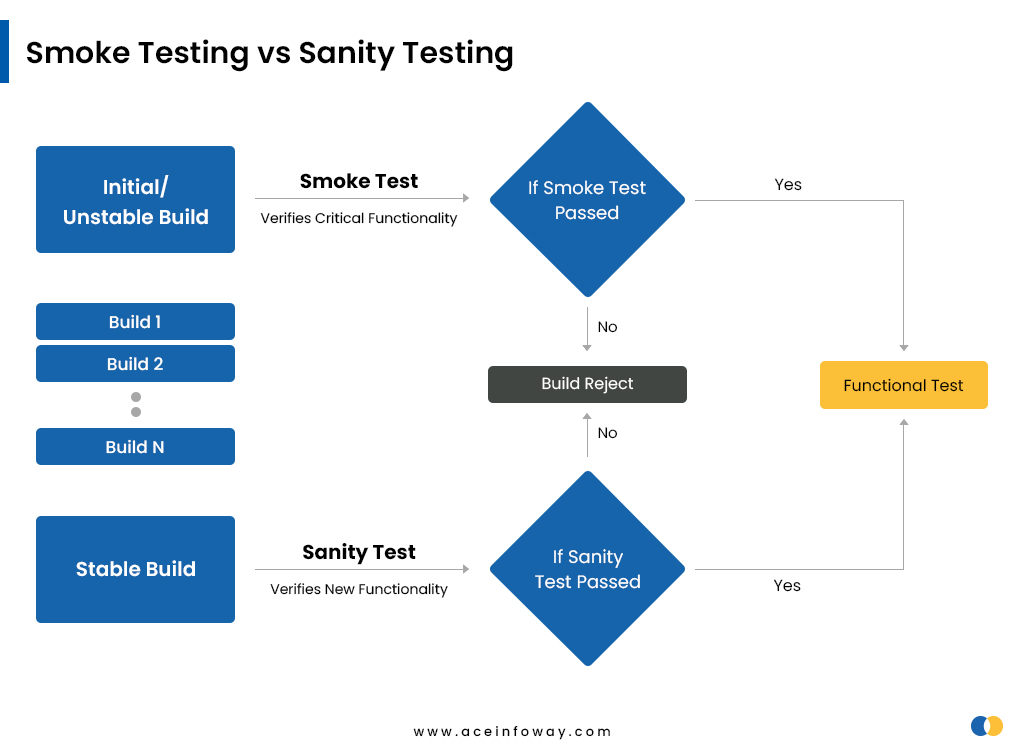Table of Contents
Validating a software for its stability and efficiency is essential to maintain customer satisfaction and prevent significant revenue losses. Moreover, in today’s fast-paced and highly competitive software development landscape, quality assurance is more critical than ever. Of myriad testing modules, smoke tests and sanity tests are two types of software testing that are designed to catch issues early in the development process before they become more significant and costly problems. Although being used on a regular basis, these two terms have collected some misconceptions around them. It is essential to understand these testing methodologies and thus know the difference between them.
Let’s dive in!
What is Smoke Testing?
Smoke testing is an initial and essential step in software testing. It is a high-level testing process that is performed to verify if the most critical functionalities of the application are working correctly. It is called “smoke testing” because, in the hardware context, smoke might be generated if a major issue occurs. Similarly, if the smoke test fails, it indicates that there is a significant problem in the application.
It ensures that the application is stable enough to move on to the next stage of testing. If the smoke test fails, the development team can immediately address the issue and fix the problems. This helps to prevent the occurrence of more significant issues later in the development cycle, which could delay the project, cause problems for users, or even result in the failure of the entire application.
Smoke testing helps to identify critical issues in the application quickly, and thus, saves a lot of time and effort for the development team. It also helps to detect major defects before conducting comprehensive testing. Smoke testing is an excellent way to test the stability of the application and ensure that it is ready for the next stage of testing.
It can be performed either manually or using automation tools. In manual testing, the test engineer runs a set of predefined test cases that verify the most critical functionalities of the application. In automated testing, the tests are scripted, and the testing tool executes them automatically. The test cases are designed to be quick and high-level, providing a general overview of the software’s functionality.
The smoke tests cover the most important features of the application, such as login, search, and payment functionality. After the smoke test is passed, the development team moves on to more comprehensive testing, and if it fails, they address the issue immediately and re-run the smoke test.

What is Sanity Testing?
Sanity testing is a type of software testing that is performed to quickly verify if the newly added functionalities or changes have not adversely affected the application’s critical functionalities. It is called “sanity testing” because it focuses on testing the basic and most important functionalities of the application to ensure that it is still sane and working correctly.
It helps to identify whether the minor changes or newly added functionalities are working as expected, which ensures the overall quality of the application. Furthermore, it is an essential step in the development process as it helps to catch any potential issues quickly, preventing them from escalating into major problems.
Sanity testing is also cost-effective, as it allows developers to catch potential problems early, preventing them from escalating into more significant issues later on. Furthermore, it helps to ensure the quality and reliability of the software application, which enhances user satisfaction.
Sanity testing is a relatively straightforward process that involves testing the essential functionalities of the application that are most likely to be affected by the changes made. The testing can be done manually or by using automation tools. The test cases are designed to be quick and targeted, ensuring that the critical functionalities of the application are working as expected.
The testing team, before moving on to more comprehensive testing, performs sanity testing to ensure that the application’s critical functionalities are still working correctly. Wherein the team verifies the basic functionalities such as login, search, and payment functionality, ensuring that they are not adversely affected by the changes made.
Smoke Test VS Sanity Test
While both smoke testing and sanity testing is used to verify the functionality of the software, there are several key differences between the two:
| Comparison Points | Smoke Test | Sanity Test |
|---|---|---|
| Purpose | Quickly verify whether the most critical functions of an application or system are working correctly | Check whether specific new features or changes have been implemented correctly |
| Scope | Covers a broad range of functionality | Focuses on a specific subset of the software’s functionality |
| Timing | Typically performed at the beginning of the testing process | Performed after more comprehensive testing has been completed |
| Depth | It is a quick and basic test | It is a more in-depth test that focuses on specific features or changes |
| Test Coverage | Checks the entire system to see if it is stable enough to proceed with more testing | Focuses on a specific area to ensure that new changes or features do not break the existing system |
| Test Cases | Designed for pre-defined and generic testing/td> | Designed specifically for the new changes or features being introduced |
| Test Results | Provides a pass/fail result | Describes more detailed reporting of issues found |
| Automation | Often automated to speed up the process | May require more manual testing |
| Tester Skills | It can be performed by testers with a basic knowledge of the software | It requires more specialized knowledge of the new changes or features being tested |
Conclusion
When it comes to software development, the timing of testing depends on the specific requirements of the project. By understanding the differences between smoke testing and sanity testing, development teams can make informed decisions about which approach to use for delivering high-quality software. Smoke testing catches major issues early in development, while sanity testing ensures that new changes do not negatively affect existing functionality.
Whether you’re launching a new software or updating an existing one, thorough testing is crucial for providing the best user experience. At our quality testing services, we have the expertise to provide both smoke testing and sanity testing, ensuring that your software or web app is working flawlessly. Our team can help you deliver software that exceeds user expectations, so don’t let bugs or glitches hold you back.






















